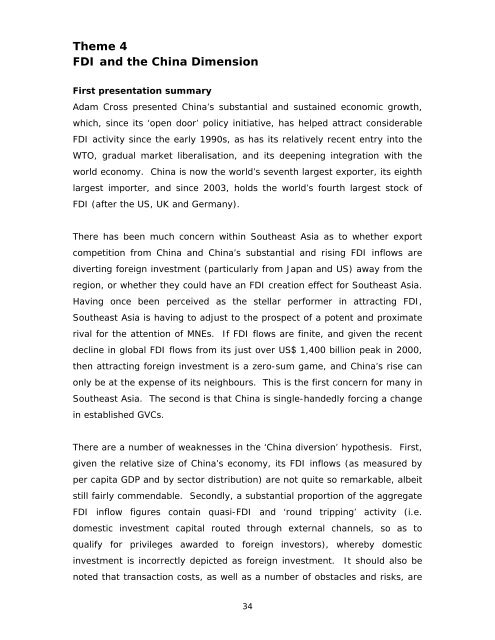(EGM) Foreign Direct Investment in Southeast Asia - Unido
(EGM) Foreign Direct Investment in Southeast Asia - Unido
(EGM) Foreign Direct Investment in Southeast Asia - Unido
You also want an ePaper? Increase the reach of your titles
YUMPU automatically turns print PDFs into web optimized ePapers that Google loves.
Theme 4<br />
FDI and the Ch<strong>in</strong>a Dimension<br />
First presentation summary<br />
Adam Cross presented Ch<strong>in</strong>a’s substantial and susta<strong>in</strong>ed economic growth,<br />
which, s<strong>in</strong>ce its ‘open door’ policy <strong>in</strong>itiative, has helped attract considerable<br />
FDI activity s<strong>in</strong>ce the early 1990s, as has its relatively recent entry <strong>in</strong>to the<br />
WTO, gradual market liberalisation, and its deepen<strong>in</strong>g <strong>in</strong>tegration with the<br />
world economy. Ch<strong>in</strong>a is now the world’s seventh largest exporter, its eighth<br />
largest importer, and s<strong>in</strong>ce 2003, holds the world’s fourth largest stock of<br />
FDI (after the US, UK and Germany).<br />
There has been much concern with<strong>in</strong> <strong>Southeast</strong> <strong>Asia</strong> as to whether export<br />
competition from Ch<strong>in</strong>a and Ch<strong>in</strong>a’s substantial and ris<strong>in</strong>g FDI <strong>in</strong>flows are<br />
divert<strong>in</strong>g foreign <strong>in</strong>vestment (particularly from Japan and US) away from the<br />
region, or whether they could have an FDI creation effect for <strong>Southeast</strong> <strong>Asia</strong>.<br />
Hav<strong>in</strong>g once been perceived as the stellar performer <strong>in</strong> attract<strong>in</strong>g FDI,<br />
<strong>Southeast</strong> <strong>Asia</strong> is hav<strong>in</strong>g to adjust to the prospect of a potent and proximate<br />
rival for the attention of MNEs. If FDI flows are f<strong>in</strong>ite, and given the recent<br />
decl<strong>in</strong>e <strong>in</strong> global FDI flows from its just over US$ 1,400 billion peak <strong>in</strong> 2000,<br />
then attract<strong>in</strong>g foreign <strong>in</strong>vestment is a zero-sum game, and Ch<strong>in</strong>a’s rise can<br />
only be at the expense of its neighbours. This is the first concern for many <strong>in</strong><br />
<strong>Southeast</strong> <strong>Asia</strong>. The second is that Ch<strong>in</strong>a is s<strong>in</strong>gle-handedly forc<strong>in</strong>g a change<br />
<strong>in</strong> established GVCs.<br />
There are a number of weaknesses <strong>in</strong> the ‘Ch<strong>in</strong>a diversion’ hypothesis. First,<br />
given the relative size of Ch<strong>in</strong>a’s economy, its FDI <strong>in</strong>flows (as measured by<br />
per capita GDP and by sector distribution) are not quite so remarkable, albeit<br />
still fairly commendable. Secondly, a substantial proportion of the aggregate<br />
FDI <strong>in</strong>flow figures conta<strong>in</strong> quasi-FDI and ‘round tripp<strong>in</strong>g’ activity (i.e.<br />
domestic <strong>in</strong>vestment capital routed through external channels, so as to<br />
qualify for privileges awarded to foreign <strong>in</strong>vestors), whereby domestic<br />
<strong>in</strong>vestment is <strong>in</strong>correctly depicted as foreign <strong>in</strong>vestment. It should also be<br />
noted that transaction costs, as well as a number of obstacles and risks, are<br />
34

















